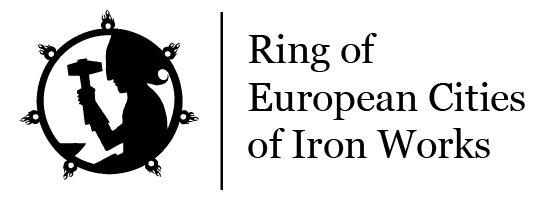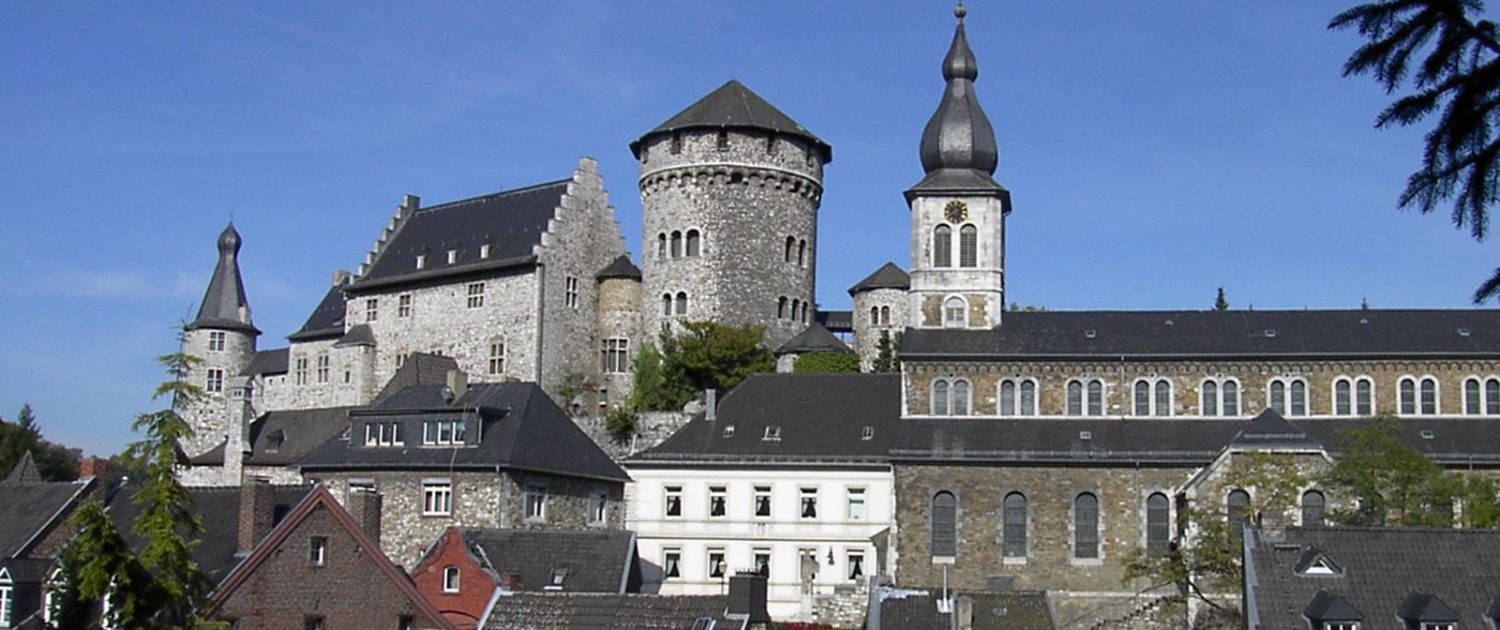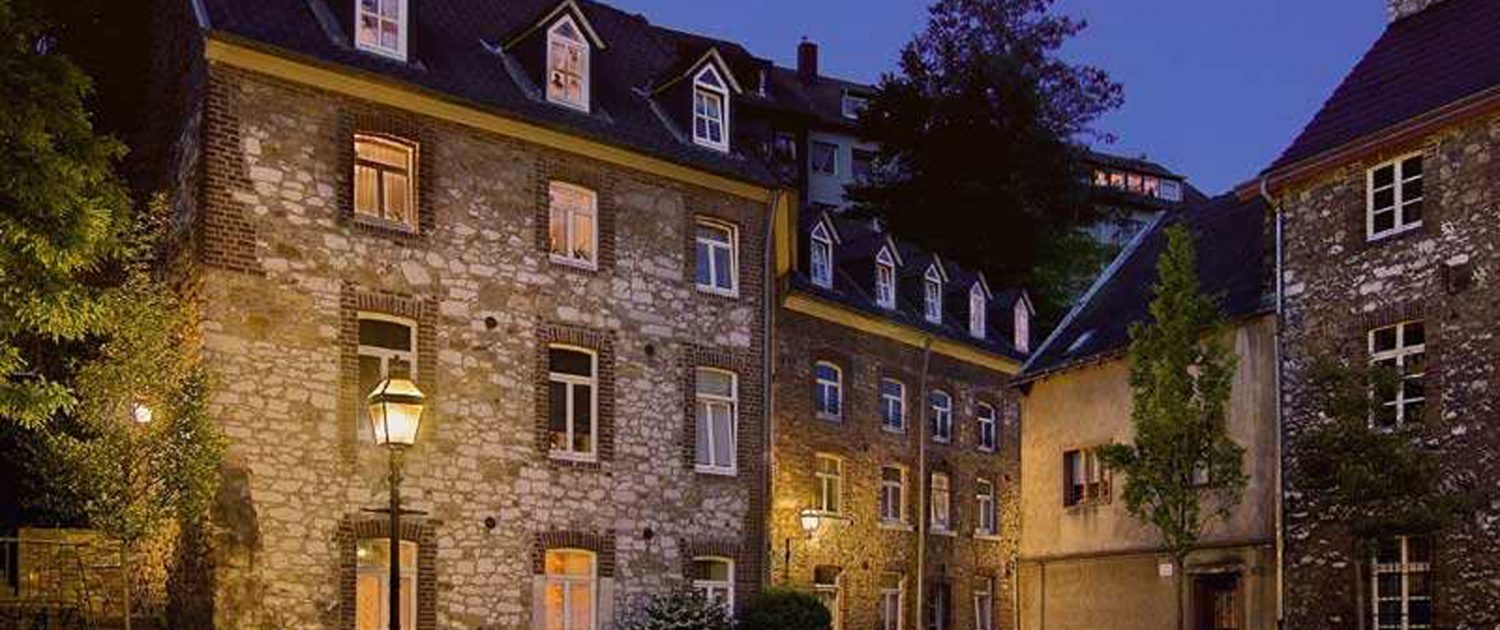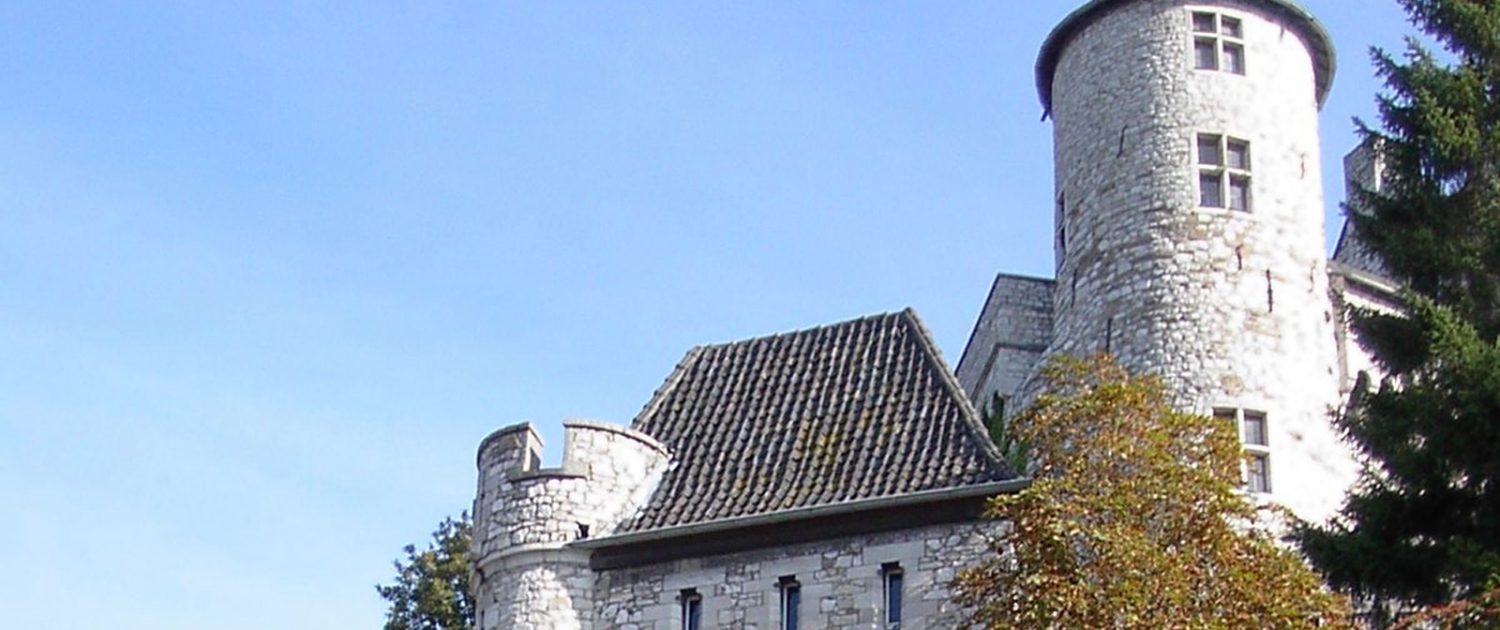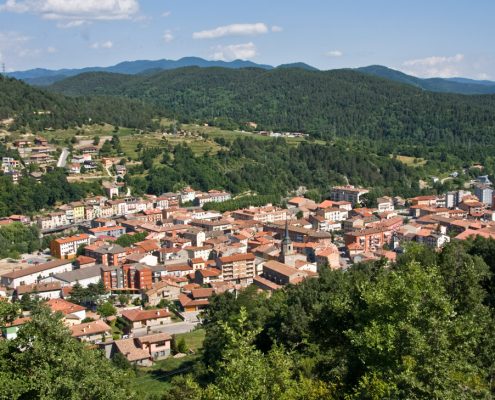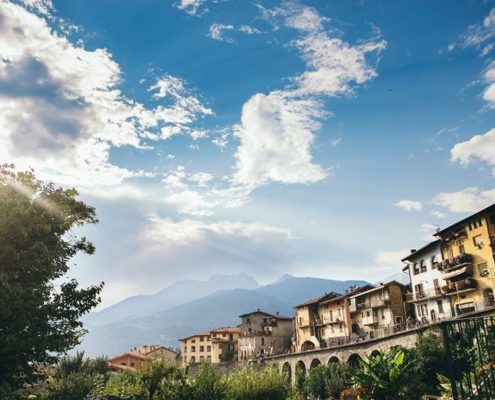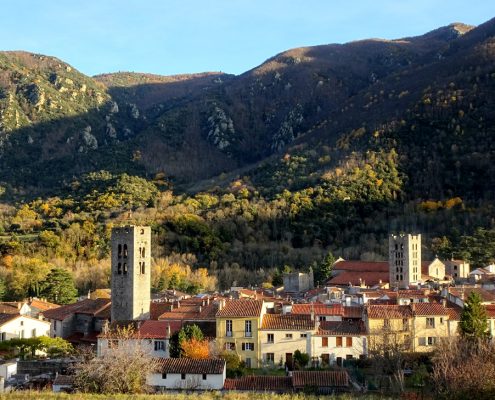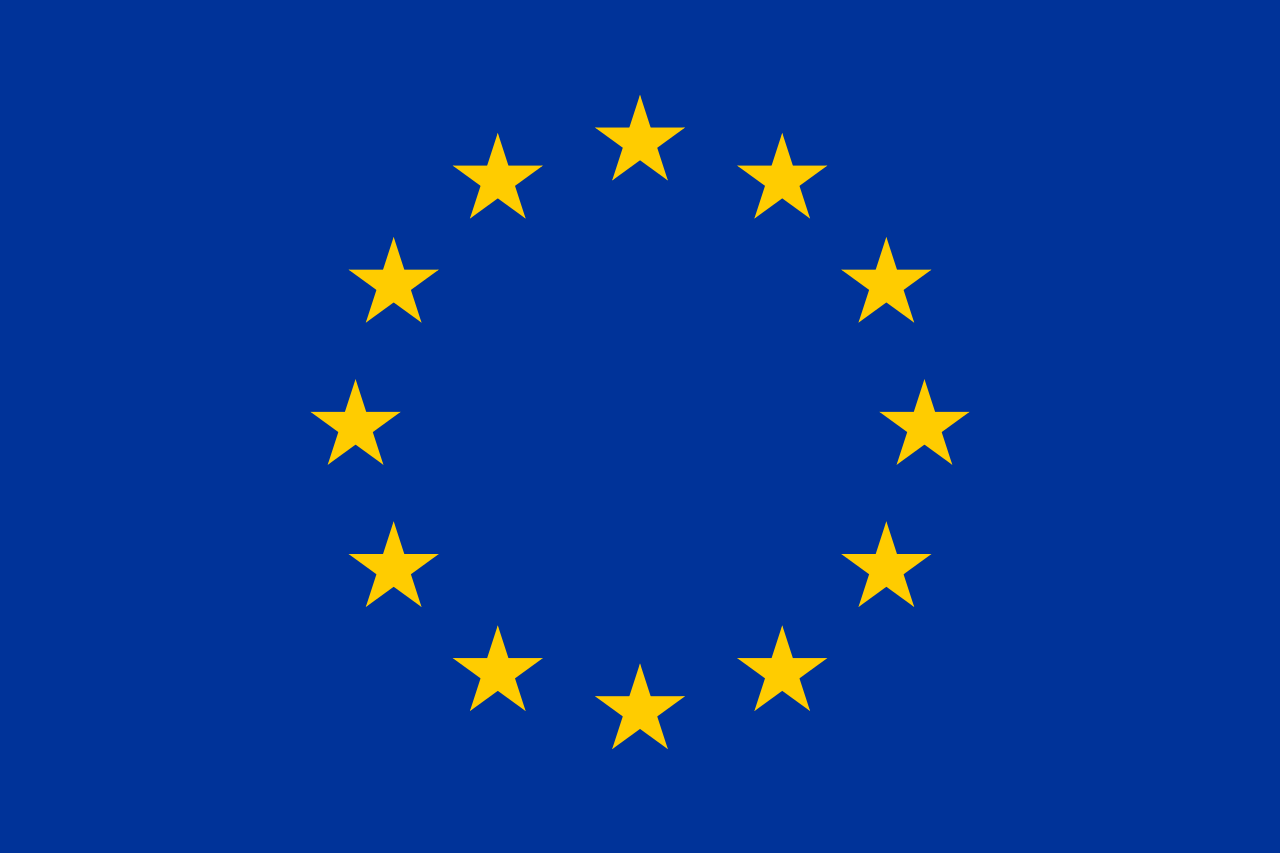Stolberg (Germany)
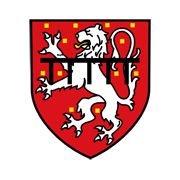
Geographical position:
Western part of Germany, 15 kilometres from Aachen
Location:
Located in Nordrhein-Westfalen, in the „Städteregion Aachen“, next to Belgium and the Netherlands (“border triangle”)
Size: 98,48 km²
Number of inhabitants: 58.000
Altitude: 260 m
Contact:
Kupferstadt Stolberg (Rhld.)
Stolberg-Touristik
Zweifaller Str. 5
52222 Stolberg
Tel.: +49 (0) 2402 9990080 / -81
Fax.: +49 (0) 2402 9990082
The Copper city Stolberg and its “Kupferhöfe”
unique, varied, attractive
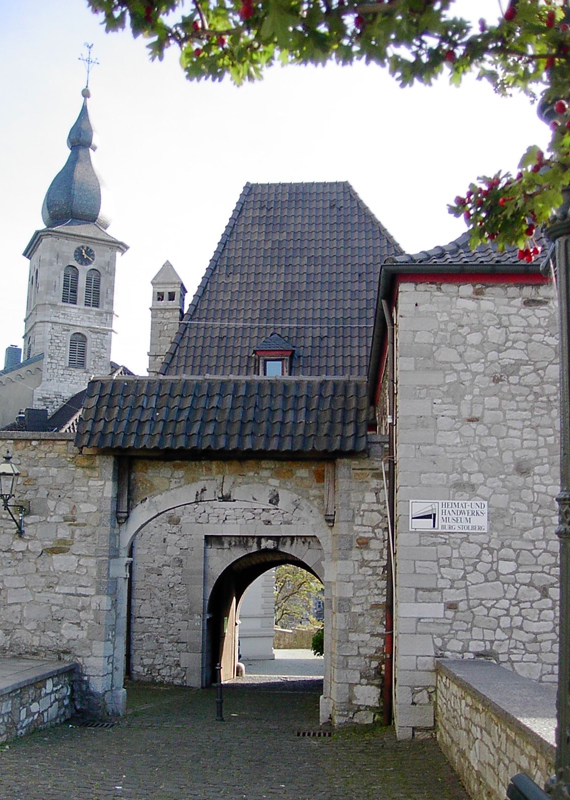 Although the former brass smelters, the so-called copper yards “Kupferhöfe”, are very characteristic for Stolberg, these courtyard buildings from the period of the Early New-Age are not at all an assembly of stereotype buildings. Anyway, there is no single “Stolberg copper yard“ that could be identified as typical in its appearance. Depending on the dating of their construction year and the wealth of their respective builders, the structural shapes of the individual courtyard buildings vary quite considerably.
Although the former brass smelters, the so-called copper yards “Kupferhöfe”, are very characteristic for Stolberg, these courtyard buildings from the period of the Early New-Age are not at all an assembly of stereotype buildings. Anyway, there is no single “Stolberg copper yard“ that could be identified as typical in its appearance. Depending on the dating of their construction year and the wealth of their respective builders, the structural shapes of the individual courtyard buildings vary quite considerably.
The terms copper master, “Kupferhöfe” (literally translated copper yards) and copper city understandably give our guests the impression that Stolberg had gained its economic importance with the production of copper. In fact the situation was slightly different: in Stolberg copper was not produced, but refined. This is how the process of brass production was understood at that time.
Early days of New-Age brass industry
In the early 1570s the Aachen habitant Leonard Schleicher, as the first copper master, recognized the location advantages important for the brass industry in the Stolberg valley (among others water power as well as nearby ore and hard coal deposits) and consequently moved his company from Aachen to Stolberg.
At today’s Burgstraße he built the first brass smelter facility in Stolberg. Until the middle of the 17th century an almost complete relocation of the brass production took place from Aachen to Stolberg.
Building shapes of the former brass smelters commonly called copper yards
After resettlement into the unfortified and sparsely populated area of Stolberg, everybody was self-responsible for the defence of his belongings and his life to a great extent. Therefore the copper yards in Stolberg were at first built as closed, well-fortified and defensible courtyard building assemblies, which usually formed a courtyard completely enclosed by residential and factory buildings as well as stables. This complex was accessible by only one well-fortified gate. With the windows all facing the courtyard, the external appearance of a courtyard building resembled a fortress and therefore its exterior view was not very appealing and inviting.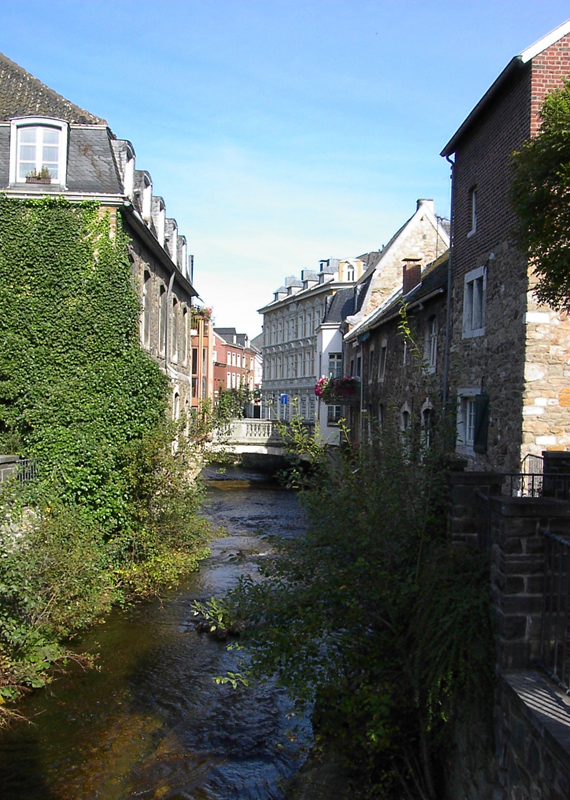
In the heyday of the brass industry and in the course of the increasing wealth of the copper masters, who became more and more self-confident, significantly more representative complexes were built in the 18th century. As regards size and furnishings, the residential units developed into spaciously laid out manor houses surrounded by well-tended, park-like gardens, which until today give the impression of feudal manors.
Former brass smelters in the Stolberg valley – modern life and old architecture
Besides the special atmosphere of the old town and the charm of the Wilhelminian Era, an extended leisurely walk through Stolberg gives an overview of the various building styles of the building assemblies commonly called copper yards, which are found throughout the whole city area where they appear as picturesque architectural elements of the townscape. Still today conception and construction of the courtyard buildings distinctly show the development of the town as well as the economic success of the brass industry in the Stolberg valley.
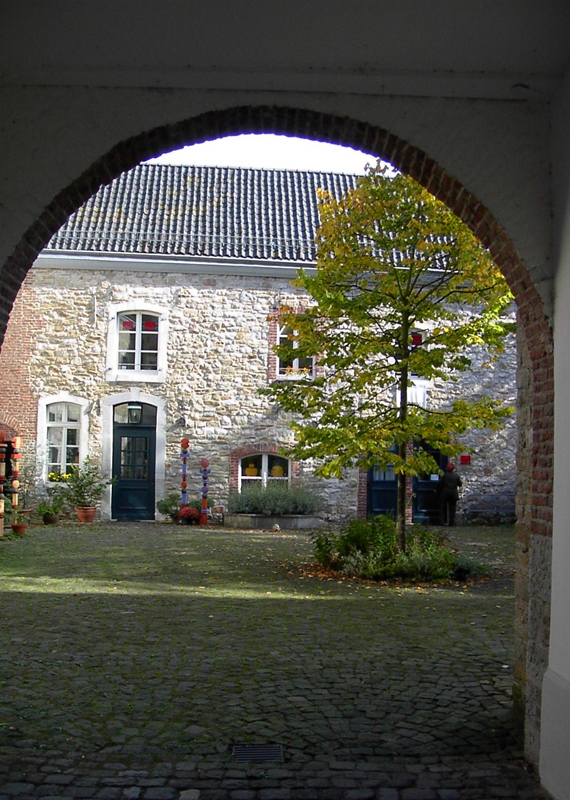 The “Kupferhof Schart“ located in the south of the old town, was built in 1600 directly at the Vichtbach in the form of a two-complex courtyard building. Today’s appearance of the “Schart” is characterized by the conversion of the building in 1808, at which the originally simple exterior facades were significantly changed.
The “Kupferhof Schart“ located in the south of the old town, was built in 1600 directly at the Vichtbach in the form of a two-complex courtyard building. Today’s appearance of the “Schart” is characterized by the conversion of the building in 1808, at which the originally simple exterior facades were significantly changed.
In 1719 the „Schart“ as the first former brass smelter in Stolberg experienced a change in its use, when Matthias von Asten acquired it to establish a cloth factory.
In 1575 the first Stolberg brass smelter was built at today’s Burgstraße, which later became the Adler pharmacy. Due to the needs of the time, also this courtyard complex was at first designed as a wellfortified building assembly, by dispensing to a great extent with a representative exterior view of the building. Today’s appearance resulted from conversion work subsequently carried out.
In 1790 one of later in total seven countryside pharmacies in the district of Aachen, which existed until 1971, was established in the former brass smelter facilities; thus it worked without interruption for almost 200 years. Today it is used as a residential building.
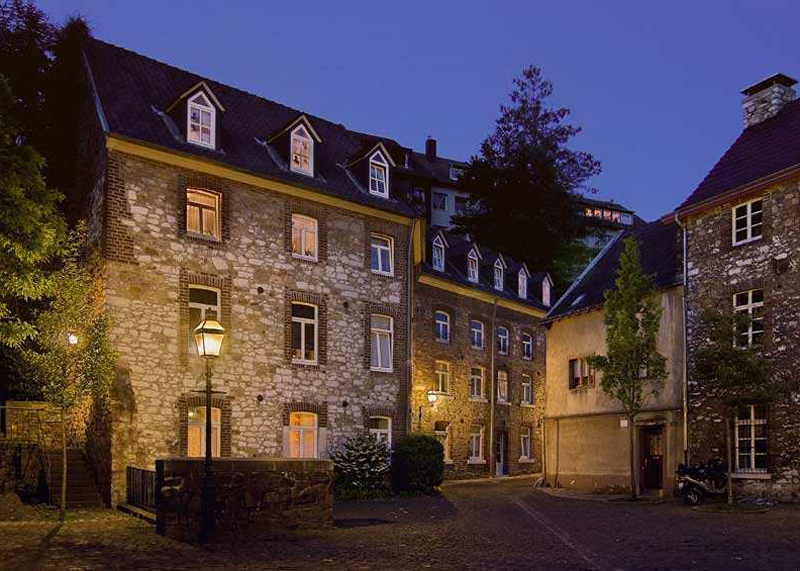 After about 100 meters the „Kupferhof Alter Markt” (copper yard old market square) can be seen, which was formerly also called „Rose“. The stucco façade dating from the 19th century does not clearly reveal the age and the original function of this building, which was constructed around 1600. Only the impressive inner courtyard of the building assembly, which today is used as a venue for the exhibition of art, gives an idea of the charm exuded by the former building.
After about 100 meters the „Kupferhof Alter Markt” (copper yard old market square) can be seen, which was formerly also called „Rose“. The stucco façade dating from the 19th century does not clearly reveal the age and the original function of this building, which was constructed around 1600. Only the impressive inner courtyard of the building assembly, which today is used as a venue for the exhibition of art, gives an idea of the charm exuded by the former building.
Along the mighty castle the way goes through the narrow, winding alleys of the romantic old town to the “Kupferhof Sonnental”. This complex was built as extension of a brass smelter facility no longer in existence today and was constructed in 1730 as an independent building assembly.
In 1835 a glass factory was established in the Sonnental, which, however, stopped its production after only 15 years. After conversion or more precisely said extension of the building complex an iron foundry was founded in 1850, which operated for more than 100 years in this place. In the course of restoration work carried out in the old town the former “Kupferhof Sonnental” was redesigned in the 1980s and an attractive residential complex was created.
Compared to the brass smelters built in earlier periods, e.g. Schart or Rose, the impression of a feudal manor cannot be avoided in case of the “Kupferhof Grünenthal”. The building assembly constructed in about 1700 with the centrally arranged manor and the two side wings built towards the front forms a generously dimensioned courtyard open to the north. In the course of its eventful history the courtyard building Grünenthal experienced several changes of use.
In 1889 the core piece of the spacious facility was bought by the family Wirtz, who moved its soap production to this place. After the Second World War the family Wirtz founded a pharmaceutical company of the same name in this location, which today is operating worldwide.
One of the most beautiful copper yards in Stolberg is the “Hof Rosental”, which was built in 1724 on behalf of Johannes Schleicher by the well-known master builder Tillmann Roland as a representative courtyard building assembly with an imposing bridge gate. In contrary to all other copper yards in Stolberg, the main building is faced with lime marl stone slabs, with the facade’s structure (window framing and surrounding edges of the brick work) being accentuated by the use of domestic bluestone. Not only thepale yellow colour of the lime marl facing, but also the overall design of the building give the building complex the character of a country castle.
The gatehouse of the “Kupferhof Stöck“ built in 1726 shows the alliance coat-of-arms of the builder couple Peltzer – Prym. The facade of the manor has been preserved in its original form, while the other parts of the building were partly destroyed by effects of war. Since its reconstruction the Stöck has served as residential building complex.
The origins of the “Weide” built by Simon Lynen go back to the year of 1615. In particular the gable and roof structures of the entry wing were redesigned in 1905 according to the trend prevailing at that time. In the interior area of the courtyard, in the southwest corner, still there is a pretty original building from the year of 1723.
Although the building assembly of the „Unterste Hof“ located in park-like surroundings today also appears as closed courtyard building assembly, it had originally not been built as such. In the beginning the building complex consisted of only two mill buildings of which the gable ends were built on to each other; they were constructed in 1612. Totally atypical is the late construction time of the manor visible from the street, which was built not before around 1850.
The courtyard is entered through a gate house built in 1712. Above the archway the coat-of arms of the family Schleicher can be seen. In the inner courtyard there is a mill house originally constructed in 1612, to which a residential complex facing the south was attached shortly after.
On the left side of the manor there is a gallery built in the Art Nouveau style around 1900. The adjacent sections of the timber framing form a frieze showing representations of the traditional trademarks of the copper masters, the so-called “Mircken”.
Eponymous for the “Unterste Hof” was its geographical location; in the flowing direction of the stream “Vichtbach” it is the last and also lowest building complex, shortly before the confluence of the streams “Vichtbach” and “Münsterbach”.
Welcome to Stolbergthe Copper Town
Nature, Technology, Culture, History.
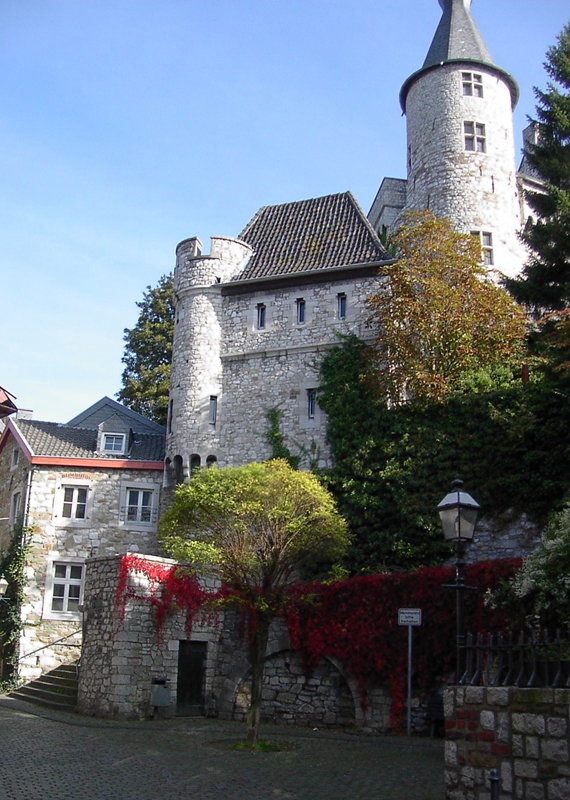 A wonderful and inspiring diversity is characteristic of the old Copper Town, Stolberg situated close to the city of Aachen. For anyone coming to Stolberg it’s a good idea to make sure your curiosity is boundless, because there is such a lot to see and discover: the copper courtyards that tell of the splendour of the pre-industrial era. Town districts set in a scenic landscape, historical centres with the Castle seated high above the historical old town, the inviting friendliness of a town with a big heart – all this and much more will make your visit to Stolberg a real experience.
A wonderful and inspiring diversity is characteristic of the old Copper Town, Stolberg situated close to the city of Aachen. For anyone coming to Stolberg it’s a good idea to make sure your curiosity is boundless, because there is such a lot to see and discover: the copper courtyards that tell of the splendour of the pre-industrial era. Town districts set in a scenic landscape, historical centres with the Castle seated high above the historical old town, the inviting friendliness of a town with a big heart – all this and much more will make your visit to Stolberg a real experience.
A melting pot throughout the centuries. Copper masters, trade, international standing
Stolberg was first mentioned in an official document in 1118. However, archaeological finds have shown that people lived here as early as 12,000 years ago. Early historical smelting locations (in particular slag) and settlement remains attest to Stolberg‘s century-old tradition as a metal metropolis.
As “global players” of the pre-industrial era, our copper masters exported their brass ware even to Africa. Product descriptions and trade names such ‘Africa or Lisbon pan’ or ‘Guinea cauldron’ testify to the international dimensions of these old distribution structures and trading networks. And to this day, top quality products start their journey into the wide world in Stolberg; these include copper alloys, glass products, lead ingots, electronic systems, haberdashery, washing detergents, pharmaceuticals and much more. But that is not all Stolberg has to offer – this Copper Town gem has since rightly become an insider tourist tip for naturelovers, culture fans and those who enjoy both.
Tranquil and inspiring: “Old” Stolberg. Churches, Pubs, Copper Courtyards.
The charm and atmosphere of the Old Town: narrow, winding streets, picturesque buildings, romantic corners and courtyards, three churches and the copper courts typical for Stolberg make a visit to the Old Town a real experience and let you forget the hustle and bustle of everyday life. On sunny days the many outdoor cafés and restaurants with their almost Mediterranean flair are the ideal place to take a break and relax.
On a gentle stroll through the town you will come across many traces of our copper masters. Having discovered the almost ideal nature of the Stolberg valley, the first Copper Courtyard was erected in 1575, in the heart of what is today the Historical Old Town just below the Castle. The protestant church Vogelsangkirche and the impressive Finkenbergkirche of the reformation community were built by the copper masters. A visit to the Finkenbergkirche rewards you with a wonderful view of the Castle and the Old Town. The neighbouring copper masters’ graveyard with the emblems and coat of arms testify to the self-esteem and the social status of the copper masters.
Chequered history: Stolberg Castle Landmark. Central point, experience.
It doesn’t matter from which direction you come into the town centre of Stolberg, the Castle is always there as the landmark and the dominant architectural element. The mighty building is poised on a rock way above the confusion of the winding streets and houses of the Old Town.
The Castle Burg Stolberg is with its regular art exhibitions in the Castle Gallery and its splendid Knights’ Hall an integral and popular part of the town’s cultural and social life.
The sophisticated gastronomy offered in the Castle is not simply eating and drinking, it offers a wonderful medieval atmosphere. Many major events like the Town Festival, the Copper Town Christmas Market, the Castle Knights’ Meeting etc. all benefit from the charisma and flair of the Castle and atmospheric castle courtyards. The forbidding manifestation of the Castle and the impressive view over the romantic Old Town make a visit to the Castle an unforgettable experience. From an architectural point of view, the Stolberg Castle is extremely interesting and one could say something of an unmistakable rarity. This construction of a castle built on a hill in the 15th and 16th century has been preserved as a typological singularity hardly to be seen anywhere else in the region.
Yellow violets in a difficult environment. Acclimatized, rare and beautiful.
The people of Stolberg are particularly proud of their calamine violets with their lovely yellow blossoms. And that is no surprise, after all this is the only region worldwide where these violets grow.
On the ore fields around Stolberg the calamine violet and other acclimatized plant species, such as armeria purpurea, form the unique calamine flora. This plant community consists of metallophytes, plants which can tolerate heavy metals and can develop on ore fields where other plant species would only have a stunted growth, if at all. During the blossoming time (May to June) the calamine violets and armeria purpurea fascinate every naturelover with a fantastic abundance of flowers on what looks like a very sparsely vegetated area. Every year many botanists come from all over to experience the calamine flora in Stolberg. Please help us to protect our botanical treasure and preserve it for posterity. Your excursion destination is at the same time also a characteristic habitat for ground-nesting birds, so please act accordingly and do not leave the marked paths. Dogs should be kept on the leash at all times.
Industry culture Down-to-earth. Innovative, cosmopolitan.
As early as the 17th century abundant mineral deposits made Stolberg one of the most important European centres for the production of brass.
From this early time of prosperity many buildings of historical importance, such as the Copper Courtyards are still well preserved. These buildings testify to the success and wealth of the copper masters who lived and worked here. At the peak of industrialisation many other business enterprises set up here and they also went on to conquer the world markets. For instance, the S-spring fastener was invented in Stolberg, which made the press fastener suitable for everyday use. After World War II, penicillin was introduced to Germany from here, chemical products and brand names such as Tabac Original and Dalli started their triumph march, and Stolberg was also the home of the blanks for the euro coins. Up until today the major Stolberg business enterprises in the metal processing, glass and pharmaceutical sectors still play a decisive part in the economic significance of the town.
Following traces, Get a feel for history.
History within reach, discovering exciting historical connections, building bridges between yesterday and today – made possible by the Stolberg museums.
For instance, the Zinkhütter Hof museum offers a wide-ranged, interesting documentation of local industrial history backed up by most interesting exhibits of brass, zinc and needles in the ‘historical workshop’. The Torburg Museum presents everyday culture that has been long forgotten, whether it is in households or craftsmanship, or displaying life at the times of the Romans or the coppers masters, or Stolberg mineral resources. Local natural environmental conditions, mining from early, medieval and pre-industrial times and an attractive conservation area with an extraordinary biodiversity can be found at Schlangenberg and impressively presented in the information centre at Breinigerberg. The sawmill museum in the scenic nature park Nordeifel reminds us of times when in the Stolberg district of “Walddorf Zweifall” up to ten sawmills manufactured planks and beams.
Celebrations in Stolberg. Art, culture, tradition.
There is always something going on in Stolberg. The people of Stolberg have always been doers: traditionally throughout the centuries they have learned how to work with metal and glass, often creating something to make a living, which others would have regarded as nothing. So it is no wonder that the lively cultural scene is rooted in the midst of the population.
Our visitors to Stolberg find such a variety of events and exhibitions, e.g. the Copper Town Christmas Market, Stolberger Musiksommer, the Old- Timer Meeting in Zinkhütter Hof, the long Museum Night or the medieval knights’ camp. The “ART TOUR de Stolberg” with its open galleries, artists’ studios and exhibitions offers a view into the Stolberg art scene. No matter where you are in Stolberg you will always come across sculptures which in their diversity and multitude underline the vivid, lively and active art scene in the Copper Town.
Get out and about. Walking, hiking, water sports.
Stolberg has lots to offer: for the ambitious, active holiday-maker or for the more relaxed culture and nature lovers. The surrounding picture-book countryside has lots to offer for everyone in recreational activities.
No matter what your hobby is – gliding, cycling, riding or hiking – you will certainly get your money’s worth. Climbers will love the boulder walls by Nideggen, divers and water sports enthusiasts can enjoy the Rursee and Blausteinsee. Cart drivers, skiers and free-climbers can pursue their passion all year round, regardless of the weather, in modern indoor halls. But there is much more to explore: the mining museums in Aldenhoven, Alsdorf, Bleialf, Hückelhoven, Mechernich and Rescheid, as well as the iron museum in Jünkerath, the beautiful Jugendstil power station in Heimbach plus the Rote Haus in Monschau all offer the opportunity to find out more about the region and its specialities.
Stolberg for discoverers. Cross-border triangle in the centre of Europe.
You too will surely love the old Imperial City of Aachen with its UNESCO World Heritage cathedral and an urban combination of medieval backdrops, Roman remains, attractive shopping promenades, endless street cafés and student pubs and clubs.
Being so close to the Belgian and Dutch border, it is easy to make a short visitto cities like Liège or Maastricht, or staying on the Germany side, an excursion to the Rhine metropolises Cologne and Dusseldorf. If you prefer things more relaxed, let yourself be caught under the spell and charm of the small old Eifel towns, Monschau, Nideggen and Heimbach or enjoy the fascination of the moor landscape of the “High Fens” or the Monschau hedge region, where old Eifel farms and country houses hide behind huge beech hedges, in the lee of the cold, stormy west wind.
Stolberg – the „Copper City“ – is a founder member of the Ring of the European Cities of Iron Works. The former IFGS President was Matthias Peters, now it is Adi Radermacher.
Every two years Stolberg organizes a huge meeting of blacksmiths.
During our Christmas market we also organize our “Christmas forging”.
This year from 4th to 7th October 2018 and during our 900 anniversary celebration, the meeting of the Ring of the European Cities of Iron Works takes place in Stolberg.
